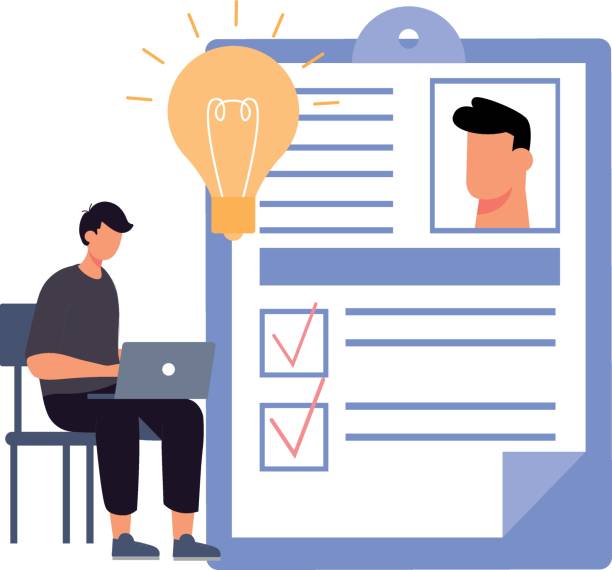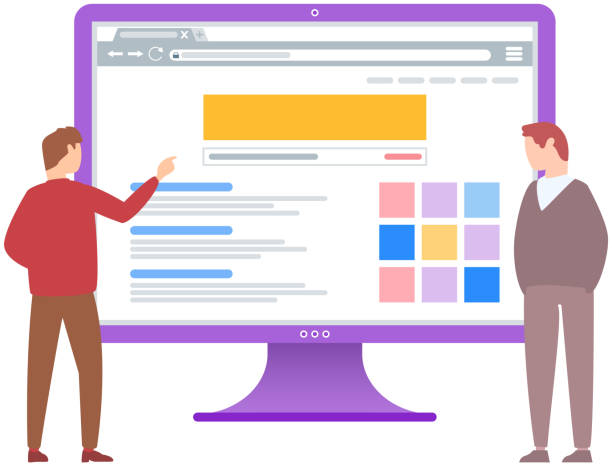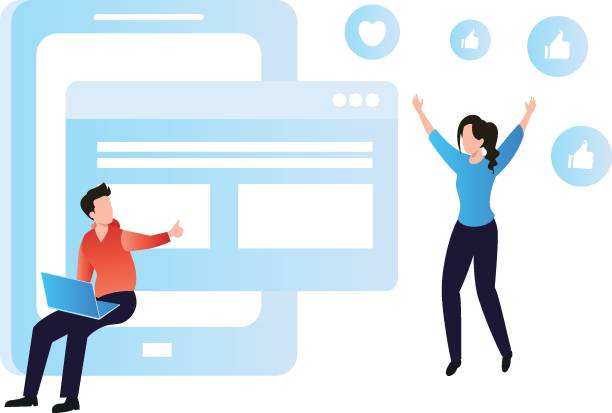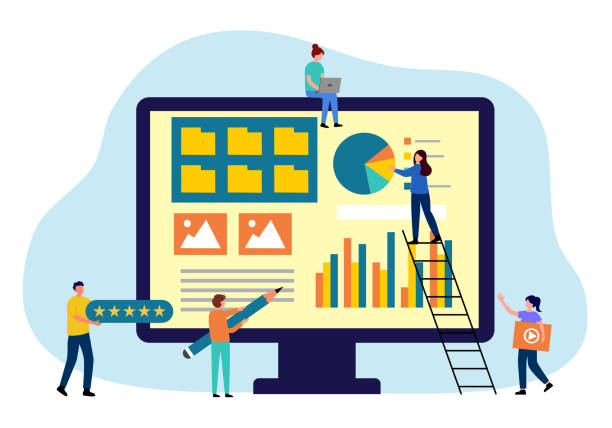An Introduction to Multilingual Websites and Their Importance in the Global Era

In today’s world, where #geographic_boundaries have vanished on the #internet, a strong #online_presence is essential for every business.
However, this presence will only truly be effective when you can communicate with audiences from all over the world.
This is where the concept of multilingual website design comes into play.
A multilingual website is not just about translating words; it involves adapting content to the culture and language of target audiences in different geographical regions.
This approach allows you to conquer new markets, expand your customer base, and strengthen your brand internationally.
Ignoring the need for a multilingual website means losing a significant portion of the global market.
With increasing internet access worldwide and a diverse user population, expectations have also changed.
Users prefer to interact with websites that offer content in their native language, even if they are fluent in other languages.
This not only helps build trust but also significantly improves user experience (UX).
A multilingual website provides a strong platform for #effective_communication with international audiences and creates new opportunities for your business’s growth and development.
This is a strategic investment that will bring long-term returns for you and paves the way for the #globalization of your commercial activities.
From a business perspective, this is a crucial step for entering new markets and increasing market share.
Are you losing business opportunities because of an outdated website? With Rasawap, permanently solve the problem of not attracting potential customers through your website!
✅ Attract more high-quality leads
✅ Increase brand credibility in the eyes of customers
⚡ Get free consultation for corporate website design
Numerous Benefits and Hidden Challenges in Multilingual Website Development

#Multilingual_website_development brings with it significant advantages, the most important of which is #access_to_new_markets and a dramatic increase in #target_audience.
By providing content in various languages, you will be able to attract more organic traffic from different countries and enhance your brand’s credibility internationally.
This is particularly crucial for companies aiming to expand their commercial activities globally.
Increased conversion rates, improved rankings in international search engines, and a reduced bounce rate are other key benefits of this approach.
When users find content in their own language, they are more inclined to interact and stay on the site.
However, a #multilingual_website_project is not without its challenges.
One of the biggest obstacles is the precise management of translations and ensuring their quality.
Machine translations may lack the necessary accuracy and cultural nuances, making the use of native, expert translators essential.
Furthermore, #international_SEO has its own specific challenges, including selecting the appropriate URL structure, managing Hreflang tags, and conducting keyword research for each language.
Maintaining and updating content in multiple languages can also be time-consuming and costly.
In addition, technical issues such as site loading speed, compatibility with various devices, and database management for multilingual content must be carefully considered.
All these aspects require meticulous planning and proper execution for your website to perform optimally and provide a seamless user experience.
Specialized Tips for the Technical Implementation of Multilingual Website Design

The #technical_implementation of a #multilingual_website_design requires a deep understanding of web architecture and SEO settings.
Choosing the appropriate URL structure is one of the most important decisions.
There are three main methods: using #subdomains (e.g., en.yourdomain.com), #subdirectories (e.g., yourdomain.com/en/), and country code top-level domains (ccTLD) (e.g., yourdomain.co.uk).
Each of these methods has its own advantages and disadvantages in terms of SEO, management, and cost.
For instance, subdirectories are generally preferred for SEO due to sharing the main domain’s authority, while ccTLDs are useful for more precise geographical targeting.
| Method | Example | Advantages | Disadvantages |
|---|---|---|---|
| Subdirectories | yourdomain.com/en/ | Best for SEO (shares main domain authority), easier management | May be less precise for geographical targeting |
| Subdomains | en.yourdomain.com | Easy separation, ability for separate hosting | May require separate authority for SEO |
| Country Code Domains (ccTLD) | yourdomain.co.uk | Best for geographical targeting, higher local trust | Higher cost and management (requires purchasing separate domains) |
Another crucial point is the correct use of Hreflang tags.
These tags help search engines display the correct language version of your website to users in different regions.
Incorrect use or errors in these tags can lead to SEO problems and penalties from search engines.
Furthermore, special attention must be paid to a #content_management_system (CMS) that supports multilingualism.
Systems like WordPress with plugins such as WPML or Polylang, or proprietary systems designed from the outset to support multilingualism, can facilitate the development process.
Optimizing loading speed and ensuring the website is responsive for all languages are also vital technical aspects in #multilingual_website_design.
These technical points form the backbone of a successful multilingual website.
Content Management and Translation Process in an International Website

#Content_management and the #translation_process_on_an_international_site are among the most complex yet crucial aspects of multilingual website design.
Translation is not merely about replacing words; it requires content localization to align with the cultural differences, dialects, and idioms of each geographical region.
The use of professional native translators who are not only fluent in the target language but also fully familiar with its culture is essential.
These individuals can ensure that your message is conveyed correctly and that no misunderstandings arise.
Machine translation tools can be a useful starting point, but they can never replace the accuracy and nuance of human translation.
In addition to text translation, media management (such as images and videos) must also be considered.
Are your images and videos suitable for all cultures? Do they need changes or replacements? These issues directly impact user experience.
A #Content_Management_System (CMS) that supports multilingual workflows can significantly simplify this process.
Features such as easy management of different language versions of content, in-page editing tools, and the ability to assign different roles to translators are vital for a successful multilingual website project.
Furthermore, creating a clear content calendar for updates and new translations greatly helps maintain content consistency and freshness across all languages.
This systematic approach ensures that your content remains accurate, relevant, and engaging for international audiences and supports #content_SEO in every language.
Are you dissatisfied with your e-commerce site’s low sales?
Rasawap is your solution for having a professional and high-selling e-commerce site.
✅ Significant increase in sales and revenue
✅ Easy and enjoyable shopping experience for customers
⚡ Get free consultation from Rasawap right now!
The Importance of User Experience (UX) in Multilingual Web Design

#User_experience (UX) plays a vital role in the success of a multilingual web design.
This is not just about content translation, but about ensuring that international visitors feel comfortable and can easily navigate your site.
One of the key aspects is the #language_selector mechanism.
This language selector should be easy to find (usually in the header or footer of the site) and clearly displayed.
Instead of using national flags, which may be inappropriate for some languages or regions, it is better to use the full name of the language (e.g., “Farsi” instead of the flag of Iran).
#Responsive_design and #adaptation_to_different_cultures are also of great importance.
Fonts, layouts, and even colors may have different meanings in different cultures.
For example, some languages are written from right-to-left (RTL), which requires changes in the user interface (UI) design to avoid disrupting the user’s visual experience.
Ensuring that all graphical elements, forms, and buttons are displayed correctly and maintain their functionality in all languages is very important.
UX leads to increased user time on site, reduced bounce rate, and ultimately, increased conversion rates.
User testing with native speakers of each language can significantly help identify weaknesses and continuously improve the user experience.
These efforts will ultimately lead to a successful and user-friendly #multilingual_website.
SEO Strategies for Multilingual and International Websites

#International_SEO for a #multilingual_website is significantly more complex than SEO for a single-language website.
The main goal is for search engines to display the correct language version of your website to appropriate users in different geographical locations.
One of the most important tools for achieving this goal is the correct use of Hreflang tags.
These tags inform Google (and other search engines) which page is an alternative version of another page in a different language or geographical region.
Errors in implementing these tags can lead to serious problems such as duplicate content and reduced rankings.
#Keyword_research must also be conducted separately for each language and region.
Keywords that are popular in one language or culture may not be effective in another.
Using keyword research tools that support local data is very important.
Furthermore, attention must be paid to #geographical_signals.
This includes using country code top-level domains (ccTLDs), geographical targeting in Google Search Console, and creating localized content for each region.
Building high-quality backlinks from local websites can also help increase your authority and ranking in that region.
Multilingual site development with a strong SEO approach ensures that your site is visible and accessible to target audiences worldwide and gains a good competitive position.
Common Mistakes in Building a Multilingual Site and Their Solutions

#Building_a_multilingual_site can come with common challenges and mistakes that, if ignored, can harm the project’s success.
One of the most frequent errors is #poor_or_machine_translation.
Using unprofessional translations can lead to misunderstandings, reduced brand credibility, and a poor user experience.
The solution is to always use native, expert translators and implement review and quality control processes.
Another mistake is #neglecting_international_SEO.
Incorrect use of Hreflang tags, inappropriate URL structure, and insufficient keyword research for each language can prevent your site from achieving good rankings in international search engines.
The solution is to consider international SEO as a main pillar from the outset of the multilingual website design process and optimize all technical and content aspects accordingly.
| Common Mistake | Explanation | Solution |
|---|---|---|
| Poor/Machine Translation | Using unprofessional translators or automatic translation tools without editing | Hiring expert native translators, implementing quality review processes |
| Neglecting International SEO | Lack of Hreflang implementation, inappropriate URL structure, poor keyword research | Correct Hreflang implementation, choosing appropriate URL structure, in-depth keyword research |
| Inadequate User Experience | Ignoring text direction (RTL/LTR), fonts, unclear language selector | Localized design, clear language selector, testing with native users |
| Complex Content Management | Absence of an efficient CMS for multilingual content | Choosing a suitable CMS with multilingual capabilities (e.g., WPML, Polylang) |
Furthermore, neglecting #localized_user_experience is also a common mistake.
Each language and culture may require different fonts, text direction (such as right-to-left for Persian or Arabic), and even different layouts.
Failure to address these details can lead to a frustrating user experience.
With meticulous planning, hiring suitable specialists, and continuous monitoring, these mistakes can be avoided, leading to a successful #multilingual_project.
Multilingual website design requires attention to detail and a long-term vision.
Practical Tools and Platforms in Multilingual Website Design

For #multilingual_website_design, numerous tools and platforms can simplify the process.
Choosing the right tool depends on your team’s needs, budget, and expertise.
Content Management Systems (CMS) like WordPress and Drupal support multilingual capabilities through dedicated plugins or modules.
For example, WPML and Polylang are among the most popular plugins for WordPress, providing easy translation management, language selectors, and SEO settings for each language.
In addition to CMSs, specialized website translation platforms like Weglot or ConveyThis can quickly make a website multilingual, even if your CMS doesn’t support this feature by default.
These services typically use APIs for automatic translation and then allow for manual editing of translations.
For more professional translation management, Translation Management Systems (TMS) tools such as MemoQ or Trados can also be beneficial, more suitable for large organizations with high content volume.
These tools help maintain terminological consistency, manage Translation Memory, and improve translator productivity.
Multilingual website design will be more efficient and higher quality using these tools.
Do you dream of a thriving online store but don’t know where to start?
Rasawap is your comprehensive solution for e-commerce website design.
✅ Attractive and user-friendly design
✅ Increased sales and revenue⚡ Get free consultation
The Future of Multilingual Web and Emerging Trends

The #future_of_multilingual_web is increasingly moving towards #artificial_intelligence and #machine_learning.
Advances in Neural Machine Translation (NMT) have significantly improved the quality of automatic translations, although human review is still necessary for sensitive or specialized content.
These technologies can provide faster and more cost-effective translations that are transforming the process of multilingual website design.
It is anticipated that in the near future, tools will emerge that can localize content in real-time with high accuracy, offering a completely personalized user experience.
Another emerging trend is #voice_search and its role in the multilingual web.
With the increasing use of voice assistants and smart devices, optimizing content for voice search in different languages is gaining increasing importance.
This requires an understanding of speech patterns and natural language queries in each culture.
Also, #interactive_content and virtual/augmented reality also have great potential for a multilingual experience, where audio and visual content can be provided in different languages.
The globalization of the internet and increased access to it in developing countries also mean an increased demand for multilingual websites that can meet the needs of a wider range of users.
These exciting trends predict a bright future for the #multilingual_web_platform and double down on the emphasis on the need for expertise in this field.
Conclusion and Key Recommendations for Global Businesses

In summary, #multilingual_website_design is a strategic and vital investment for any business seeking to #expand_its_global_presence and #increase_its_returns in the digital age.
This goes beyond mere text translation and involves a deep understanding of cultures, languages, and user search behaviors in different parts of the world.
From choosing the right URL structure and correctly implementing Hreflang tags to precise content management and user experience localization, every aspect of this process requires attention and expertise.
The key recommendation is to consider multilingual website design as an ongoing and dynamic project.
This project requires regular updates, monitoring SEO performance, and feedback from native users.
Investing in professional translators, international SEO specialists, and appropriate content management tools can help you achieve your goals.
Your multilingual website is not only a marketing tool but also a powerful communication bridge with international customers and a symbol of your respect for global cultural diversity.
By considering these points, you can establish a strong, effective, and sustainable presence in global markets and achieve unprecedented growth and success.
This is a way to gain a competitive advantage and reach your business’s long-term goals.
Frequently Asked Questions
| Question | Answer |
|---|---|
| What is a multilingual website? | A website whose content is available to users in more than one language. |
| Why should I make my website multilingual? | To access more audiences in global markets, improve user experience, and boost international SEO. |
| What are the technical approaches to building a multilingual site? | Using subdirectories, subdomains, or URL parameters to differentiate languages. |
| How does multilingual design affect SEO? | By targeting local keywords and providing content in users’ native languages, the site’s ranking in search engines for those regions improves. |
| What are the challenges of multilingual website design? | Managing content translation, supporting Right-to-Left (RTL) orientation, technical issues related to language addressing, and maintaining design consistency. |
| How do we choose the languages for a multilingual site? | Based on analysis of target audiences, target markets, and current site traffic data (if available). |
| What is RTL support and why is it important for some languages? | Right-to-Left refers to the display direction of text and page elements from right to left, which is essential for languages like Persian, Arabic, and Hebrew. |
| How do we manage multilingual website content? | Using Content Management Systems (CMS) with multilingual capabilities, translation plugins, or professional translation services. |
| What is the user experience (UX) like on a multilingual site? | The ability to change languages must be easily available, and translated content must be of high quality for users to feel comfortable. |
| What are common CMS platforms for multilingual sites? | WordPress (with plugins like WPML), Joomla, Drupal, and Shopify (with relevant settings or plugins). |
And other advertising services by Rasa Web Advertising Agency:
Smart Sales Automation: A dedicated service for increasing website traffic based on attractive UI design.
Smart Marketplace: Professional optimization for analyzing customer behavior using key page optimization.
Smart Link Building: Transform digital branding with the help of Google Ads management.
Smart Digital Advertising: An innovative platform to improve website traffic with intelligent data analysis.
Smart Conversion Rate Optimization: A fast and efficient solution for digital branding, focusing on SEO-driven content strategy.
And over hundreds of other services in the field of internet advertising, advertising consultation, and organizational solutions.
Internet Advertising | Advertising Strategy | Advertorials
Resources
- Complete Guide to Online Business Globalization
- How to Design a Successful Multilingual Website?
- The Importance of Content Translation in Attracting International Audiences
- 10 Key Tips for Internationalizing Your Website
? In today’s digital world, your business’s success is just a click away. Rasawap Afarin, by providing comprehensive digital marketing services including exclusive website design, SEO, and social media management, paves your way to visibility. With us, your brand will shine at its peak.
📍 Tehran, Mirdamad Street, next to Bank Markazi, Southern Kazeroun Alley, Ramin Alley, No. 6

